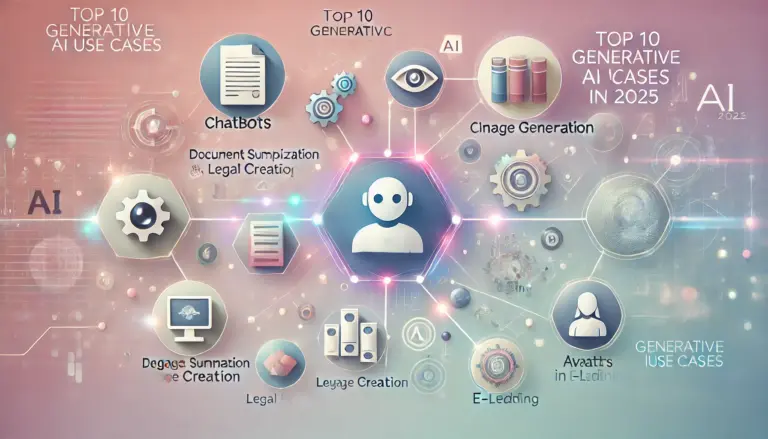Unless you live in a remote forest without access to electricity or the internet, you’ve probably noticed the recent buzz surrounding artificial intelligence. So much has been said on the internet, in advertisements, and even on stickers on washing machines, that it might seem like AI was born yesterday.
AI has actually been around for many years. We just weren’t told that algorithms (like the one that displays recommended products on Amazon) use AI models every day. But then where does all this enthusiasm come from?
The big innovation introduced a couple of years ago concerns generative AI . Generative AI wasn’t invented in 2022, but its interfaces have never been as intuitive as they are now. Today, if all you know how to do with a computer is type on a keyboard, you can use generative AI. This is the big innovation of the century.
What is generative AI?
Before we move on to discussing what generative AI is , we need to take a step back and define what AI is .
Artificial intelligence is a technology that enables machines to simulate human learning, creativity, problem-solving, and understanding. Any algorithm that can make predictions is AI, and any software that can recognize patterns in unstructured data is AI.
Generative AI is a specific type of AI. It’s an artificial intelligence capable of producing content. What type of content can it produce? Any type: text, images, video, audio, and data.
Generative AI, let’s be clear, wasn’t born two years ago. However, it’s only recently become so advanced that users can talk to it and create content simply by asking it to do so.
How does generative AI work?
The mechanism for using generative AI is simple: you enter a message and the technology creates the requested content.
Early versions of this technology required users to submit their requests through an API or other complicated process. Today, users can send their messages in text form, using their native language instead of programming and coding languages.
With the latest advancements, users can also provide feedback on AI-generated content, which will then be used to tailor the content accordingly.
This is how generative AI works on the user side. But what happens behind the scenes?
Generative AI models
If generative AI can create content, it’s thanks to generative models . Here’s how they generally work:
- Training data is provided.
- They learn patterns from the data set.
- They apply this knowledge to generate new content in response to the information provided.
The most popular generative AI interfaces
Some of the most popular generative AI interfaces in 2025 are:
ChatGPT , the one that started the aforementioned hype, is an AI-powered chatbot that provides one of the simplest ways to interact with generative AI. Users can make requests through the chat, simply by asking the chat to do something. The chat responds with the requested content.
DALL-E is a generative AI trained on many images and their corresponding text descriptions. It can create images from a text request.
Gemini . It’s Google’s generative AI and is a sort of virtual assistant for Google devices and more.
Generative AI In 2025: Top Use Cases
1) Chatbots to improve customer service . ChatGPT-based platforms offer personalized customer service 24/7. The chatbot is trained with the organization’s data and will improve over time as it works.
2) Professional photography . Professional photography has become essential in any industry. Companies need it for their corporate website, freelancers need it for their online content, and marketers need it for their campaigns. AI-powered tools help you edit and create photos and reduce the time it takes to create them.
3) Content Marketing . Generative AI helps generate ideas for new content and create content. Tools like ChatGPT and Claude are used to create professional drafts and support the work of professional creatives. AI-powered tools are also being used to streamline proofreading, scheduling, and other tasks that improve the workflow for generating quality content.
4) Report Summary . In any company with multiple departments, reports are used to store and share information. Reading these reports can often be time-consuming, especially when you need to provide a single piece of information to your boss and must find it in a 42-page report. In this case, you can use AI-based tools to summarize documents and find what you’re looking for within the report. For example, you can ask the AI specific questions, and the tool will respond with the requested data in a matter of seconds.
5) Video Production . You can use AI-powered tools to streamline every stage of video production. These help outline scripts, produce video content, review generated videos, summarize feedback, and improve post-production editing.
6) Avatars for e-learning . AI-generated avatars provide engaging learning materials. With AI-powered tools, creating an avatar can be easy.
7) Automate subtitles and dubbing . AI-powered tools create automatic subtitles and automatically sync them with the dialogue. They also enhance and automate dubbing. Both processes simplify the creation of educational content and any content that needs to be available in multiple languages.
8) Automate email responses . AI-powered tools automatically respond to emails by mimicking human speech.
9) Legal documents . Writing legal documents can be time-consuming, especially since regulations and laws need to be cited. Artificial intelligence-based tools assist professionals in generating these documents.
10) Automate references in academic articles . AI-powered tools automatically identify, write, and format citations in academic articles according to specific citation styles (APA, MLA, or others).
Conclusion
Generative AI is transforming our daily lives by simplifying workflows, enhancing creativity, and automating complex tasks across all industries.




